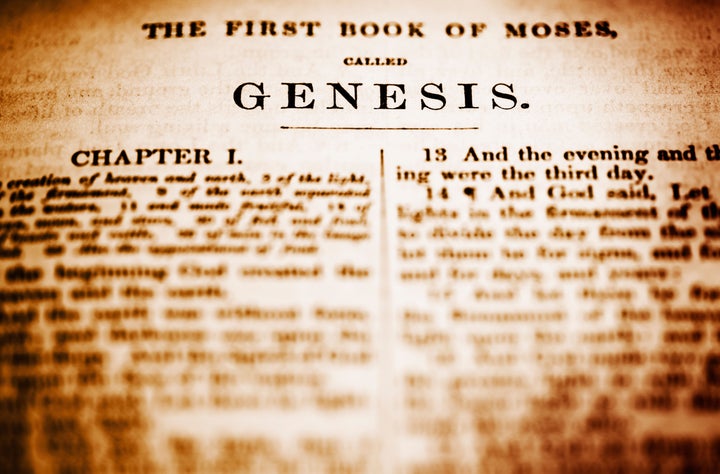
For more than a century the creation vs. evolution debate has raged in numerous countries, nowhere more strongly than in the United States and the United Kingdom. Its sensationalist forms are fodder for the media: the Scopes "Monkey Trial" in 1925, the Arkansas trial of 1981, the "Intelligent Design" notion, the "Young Earthers" and the continuing controversy over what to teach in schools. Science friction.
While science and religion operate with different methods, criteria, aims and subject matter, neither has to dominate the other. Our new book, "The Meaning of the Bible: What the Jewish Scriptures and Christian Old Testament Can Teach Us" (HarperOne, 2011), engages such contemporary issues directly by exposing the variety of ways in which the texts of the Bible address them, often from quite different perspectives. We are especially attentive not only to dissimilar positions taken within the Bible but to the kinds of questions they help us frame about both the past and the present.
Creation is an excellent example of why readers need to examine the varied expressions of a theme in the Bible. Creation was a favorite topic among ancient Israel's neighbors. For example, ancient Babylonia produced a myth about a colossal battle between the gods, at the end of which the world and humanity were created. The Egyptians viewed creation more as birthing or evolving. Biblical people were no less interested in understanding their own origins.
Readers encounter the first two accounts of creation at the very beginning of the Bible, in Genesis 1:1 - 2:4a and 2:4b-25. The former pictures God as a cosmic architect, calling everything into existence over a six-day period ending with the creation of humans, followed by a day of rest. The second story starts with the formation of humanity, followed by other living beings. Not only are the sequences and details different between the two, but the literary style shifts noticeably from highly structured, repetitious, and formal in the first to plot-driven, responsive, and intimate in the second. Most likely two different authors or traditions are behind these two stories.
In neither case do we find the notion of "creation out of nothing," an idea popularized by Saint Augustine. In Genesis 2 God uses the preexisting dry dust to form the first human. In the first account, an amorphous substance and primordial waters are the stuff out of which God creates all things: "the earth was a formless void and darkness covered the face of the deep." Here is a mythic fragment from earlier cultures: the Hebrew word for "deep" is tehom, which lacks the definite article "the" and thus seems to be a proper noun, "Deep," reminiscent of the Babylonian primordial goddess Tiamat, who represents the great salty abyss around and under the earth. Modern translations water down the biblical myth when they refer to "the face of the deep."
There is much more about creation than only what Genesis 1 and 2 present. The larger context is Genesis 1-11, all of which deals with primal times, and its purpose is to account for the makeup and character of the world as it exists. While the first two chapters display the orderliness and goodness of created reality, Genesis 3-11 show how humans introduce disorder and discord.
Evil is, in effect, created by humans in the Garden of Eden. The text does not say that the snake is Satan but rather the craftiest of animals. Adam and Eve decide themselves to disobey God's command by eating a forbidden fruit (not necessarily an apple), a seemingly petty violation with enormous implications because it represents disobedience against God. Next, wrongdoing escalates radically as Cain kills his brother Abel. Soon the world is awash with evil, and God sends the flood to obliterate everything. But misconduct returns soon after the waters recede, and by the end of the Tower of Babel story in Genesis 11 the human community is fragmented.
The Bible contains other creation descriptions outside of Genesis 1-11, a point generally lost in today's creation vs. evolution debate. Psalm 104 waxes poetic in its descriptions of God's creative acts, and in doing so it parallels many parts of a much older, beautiful song from Egypt, "The Great Hymn to the Aten," written around the 14th century BCE. In Job 38-41 following the long argument between Job and his friends, God responds with picturesque images of creation. Several sections in Isaiah 40-55, stemming from an unknown prophet during the Babylonian exile in the sixth century BCE, reinterpret the creation account to show a new creation that God will produce to greet the Judeans as they return from exile to their homeland.
The Bible does not claim a unified, monolithic portrait of creation. Its descriptions vary from text to text, as do its literary styles. It expresses how the material and human world came into existence, but its real message is not those external details but its insights into the nature of divinity, humanity, and the world.
To answer the perennial question "Why?", the Bible tells a story and sings a song.